Panasonic Lumix G Vario HD 14-140mm f/4.0-5.8 Mega OIS
Panasonic Lumix G Vario HD 14-140mm f/4.0-5.8 Performance
Sharpness in the centre of the image area at 14mm is already outstanding at maximum aperture, with the clarity towards the edges just about reaching good levels. Stopping down improves the sharpness towards the edges, although not by much with peak quality across the frame being achieved between f/5.6 and f/8.With the lens zoomed to 35mm, overall sharpness is reduced, but remains very good in the centre of the image area at maximum aperture. Towards the edges clarity is good between f/5 and f/8, with diffraction taking a bite out of resolution at smaller apertures.
Finally, at 140mm sharpness in the centre remains very good at maximum aperture, but the clarity towards the edges of the frames is reduced to fairly good levels. Stopping the lens down doesn't improve the quality towards the edges by much and sharpness in the centre remains good until f/11.
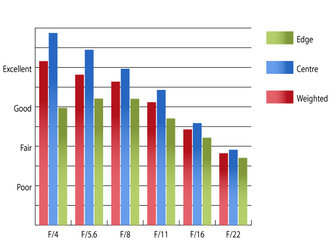 Resolution at 14mm | 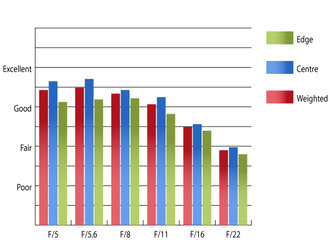 Resolution at 35mm | |
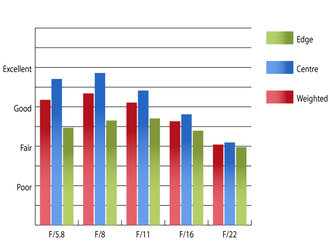 Resolution at 140mm | How to read our chartsThe blue column represents readings from the centre of the picture frame at the various apertures and the green is from the edges. Averaging them out gives the red weighted column.The scale on the left side is an indication of actual image resolution. The taller the column, the better the lens performance. Simple. For this review, the lens was tested on a Panasonic Lumix DMC-GF3 using Imatest. |
For a high ratio zoom lens like this, chromatic aberrations are very well controlled throughout the zoom range. Fringing is at its most prominent at 14mm, but does increase to noticeable levels towards the edges of the frame unless the lens is stopped down beyond f/16.
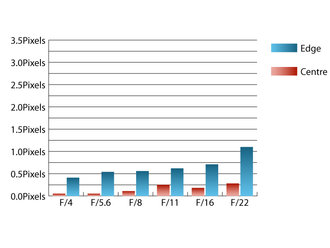 Chromatic aberration 18mm | 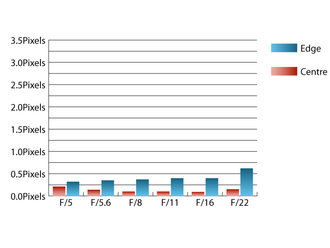 Chromatic aberration 35mm | |
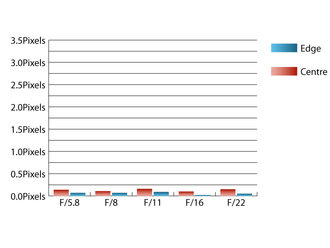 Chromatic aberration 140mm | How to read our chartsChromatic aberration is the lens' inability to focus on the sensor or film all colours of visible light at the same point. Severe chromatic aberration gives a noticeable fringing or a halo effect around sharp edges within the picture. It can be cured in software.Apochromatic lenses have special lens elements (aspheric, extra-low dispersion etc) to minimize the problem, hence they usually cost more. For this review, the lens was tested on a Panasonic Lumix DMC-GF3 using Imatest. |
Falloff of illumination towards the edges of the frame is well controlled throughout the zoom range. At 14mm the corners are 1.19 stops darker than the image centre at f/4 and visually uniform illumination is achieved by f/5.6. At 140mm the corners of the frame are only 1.05 stops darker than the image centre and visual uniformity is attained by f/8.
Distortion is also very well controlled for such a high ratio zoom. At 14mm 1.21% barrel distortion is present, and at 140mm this is replaced with 0.229% pincushion distortion. The distortion pattern remains constant across the frame throughout the zoom range, which should make corrections in image editing software afterwards relatively easy to apply.
No issues with flare were encountered during testing and only a slight loss of contrast can be seen when shooting into the light at 140mm. A petal shaped hood is supplied as standard with the lens, which does an excellent job of shielding the front element from extraneous light.
Add your message
Login required
Please login here or if you've not registered, you can register here. Registering is safe, quick and free.
Please login here or if you've not registered, you can register here. Registering is safe, quick and free.
photodo Stats
1102 lenses
428 MTF tests
74 in-depth photodo reviews
100+ users join each day
Help the lens community by reviewing or rating a lens today via our lens search
428 MTF tests
74 in-depth photodo reviews
100+ users join each day
Help the lens community by reviewing or rating a lens today via our lens search
Latest Lens Reviews
- Chinon 28mm f/2.8 Vintage Lens Review
- Canon EF 70-200mm f/4L IS II USM Lens Review
- Samyang AF 85mm f/1.4 EF Review
- Sigma 70mm f/2.8 DG Macro Art Review
- Samyang AF 24mm f/2.8 FE Review
- Meike 50mm f/1.7 Review
- Tamron 70-210mm f/4 Di VC USD Review
- Lensbaby Burnside 35mm f/2.8 Review
- Asahi Super Takumar 50mm f/1.4 Review
- Asahi Super-Multi-Coated Takumar 135mm f/3.5 Review
